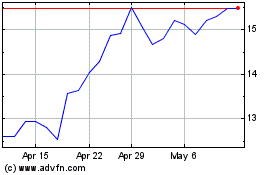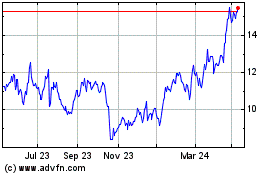Telix In-Licences Novel Tumour Microenvironment PET Tracer
09 September 2021 - 3:34PM

Telix In-Licences Novel Tumour Microenvironment PET Tracer
Telix Pharmaceuticals Limited (ASX: TLX, Telix, the Company) today
announces that it has entered into an exclusive licence agreement
for a novel positron emission tomography (PET) radiotracer that
originates from the Université catholique de Louvain (UCLouvain).
The investigational-stage PET radiotracer, known
as [18F]-3-fluoro-2-hydroxypropionate or [18F]-FLac, has
demonstrated promise for imaging lactate metabolism in oxygenated
tumours and tumour microenvironment (TME). This is based on the
observation that many types of human tumours consume lactate as a
respiratory fuel.
The most widely used commercial PET tracer today
is 2-deoxy-2-[18F]-fluoro-D-glucose ([18F]-FDG), a radiolabelled
glucose molecule that is used in ~90% of scans. Imaging with
[18F]-FDG PET is used to determine sites of abnormal glucose
metabolism and can characterise and localise many tumour types.
However, [18F]-FDG PET relies on the cancer cells having a high
metabolism and uptake of glucose, which means that [18F]-FDG cannot
discriminate those tumours and TMEs that are well supplied with
oxygen or not.
Professor Pierre Sonveaux and his team at
UCLouvain have demonstrated that many types of cancer cells
cultured under oxygenated conditions can use lactate as a
respiratory fuel,1 and have developed an [18F]-labelled lactate
analogue ([18F]-FLac) that enables imaging of lactate metabolism in
oxygenated tumour regions.2 Telix will collaborate with Professor
Sonveaux’s team to explore whether [18F]-FLac may offer an
alternative diagnostic modality, where glucose metabolism is
reduced and [18F]-FDG is not performing, by imaging lactate
transport mechanisms. [18F]-FLac could act as an adjunct to
[18F]-FDG imaging and help to identify cancers that are more
aggressive in nature and less responsive to current treatments,
particularly immuno-oncology therapeutics.
Pierre Sonveaux, Professor at UCLouvain and
Research Director at the Belgian National Fund for Scientific
Research (F.R.S.-FRNS) stated, “Our early research into the tumour
microenvironment has shown that [18F]-FLac holds great promise as a
novel PET tracer for detection of tumours that are difficult to
image with [18F]-FDG. Being able to reliably detect these tumours
and to take into consideration their metabolic activities holds
great clinical significance for the management of many different
cancers. We are also very pleased that the owner of the patent has
decided that his returns from the licence fee will be given to
charitable institutions. We look forward to working with Telix to
continue the development of [18F]-FLac and its potential role in
improving outcomes for cancer patients.”
Telix Chief Scientist, Dr. Michael Wheatcroft
added, “This is a very exciting and novel tumour tracer with the
potential to complement the ‘universal’ PET agent [18F]-FDG to
improve the detection of all tumours. Importantly, there are also
synergies of this imaging agent with Telix’s carbonic anhydrase IX
(CA9) program and overall strategy to use our understanding of
tumour microenvironment to target difficult-to-treat hypoxic
tumours and make them more susceptible to treatment. Ultimately our
aim with [18F]-FLac is to empower oncologists with more
information; to identify disease that they wouldn’t otherwise have
seen with solid or fibrotic tumours, and steer Telix’s tumour
microenvironment (TME) program into new indications. We are
delighted that the inventor, Professor Sonveaux, will continue to
be personally involved in this research as well as an advisor for
Telix’s broader TME program.”
___________________________________
1 Sonveaux P et al. J. Clin. Invest. 2008;118:3930-42.2 Van Hée
VF et al. Oncotarget 2017;8:24415-28.
About
[18F]-FLacThe
tracer, [18F]-3-fluoro-2-hydroxypropionate ([18F]-FLac), was
developed by a consortium of academic researchers directed by
Pierre Sonveaux, Professor at UCLouvain and Research Director at
F.R.S.-FRNS. The team was supported by grants from the European
Research Council (ERC No. 243188 TUMETABO), European Union’s
Horizon 2020 Marie Skłodowska-Curie (No 642623 – RADIATE), an
Interuniversity Attraction Pole (IAP) (grant No. UP7-03), the
Belgian Science Policy Office (Belspo), an Action de Recherche
Concertée from the Communauté Française de Belgique (ARC
14/19-058), the F.R.S.-FNRS, the Télévie (a Belgian charity) and
the Fonds spéciaux de la Recherche (FSR) at UCLouvain.
About Telix
Pharmaceuticals Limited
Telix is a biopharmaceutical company focused on
the development of diagnostic and therapeutic products using
Molecularly Targeted Radiation (MTR). Telix is headquartered in
Melbourne, Australia with international operations in Belgium,
Japan, and the United States. Telix is developing a portfolio of
clinical-stage products that address significant unmet medical need
in oncology and rare diseases. Telix is listed on the Australian
Securities Exchange (ASX: TLX). For more information visit
www.telixpharma.com and follow Telix on Twitter (@TelixPharma) and
LinkedIn.
Telix Media Contact
Dr. Stewart HolmstromTelix Pharmaceuticals
LimitedDirector Corporate CommunicationsEmail:
stewart.holmstrom@telixpharma.com
Telix Pharmaceuticals (ASX:TLX)
Historical Stock Chart
From Jan 2025 to Feb 2025

Telix Pharmaceuticals (ASX:TLX)
Historical Stock Chart
From Feb 2024 to Feb 2025
